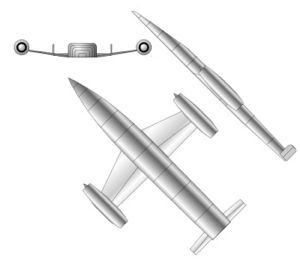
Home - Search - Browse - Alphabetic Index: 0- 1- 2- 3- 4- 5- 6- 7- 8- 9
A- B- C- D- E- F- G- H- I- J- K- L- M- N- O- P- Q- R- S- T- U- V- W- X- Y- Z
Keldysh Bomber
 Keldysh Bomber Credit: © Mark Wade |
Status: Design 1946. Payload: 8,000 kg (17,600 lb). Thrust: 900.00 kN (202,320 lbf). Gross mass: 100,000 kg (220,000 lb). Height: 28.00 m (91.00 ft). Diameter: 3.60 m (11.80 ft).
Among the advanced designs seized by Soviet forces as they overran Germany was the Saenger-Bredt Antipodal Bomber. This manned spaceplane particularly fascinated Stalin, to the extent that he instructed the NKVD to attempt to kidnap Saenger from his post-war exile in Paris. This did not come to pass, but in the immediate post-war period development of a Soviet version of this project was given the highest priority.
On 29 November 1946 the NII-1 NKAP research institute was formed with Mstislav Vsevolodovich Keldysh as its head to investigate and develop the Saenger-Bredt design. Through 1947 studies revealed that the high fuel consumption of Saenger's pure rocket design made the concept unworkable in the near term. Using engines thought to be available in the near term, 95% of the winged vehicle's lift-off mass would have to be propellant. However use of ramjets during the acceleration process would allow the spacecraft to have a more reasonable 22% dead weight fraction and still achieve the 5 km/sec cut-off velocity required for the 12,000 km intercontinental range.
It was clear from the preliminary study that an immense amount of work needed to be done before even a draft project of a feasible design could be prepared. However this would be accomplished by the mid-1950's. The Keldysh design would lead through the EKR and MKR to the Buran and Burya Mach 3 intercontinental ramjet missiles.
The Keldysh Bomber had a length of 28 m, a wingspan of 15 m, and a fuselage cross section of 3.6 m x 1.8 m. Wing area was 126 sq. m which allowed a landing speed of 200 km/hr. The 100 metric ton vehicle lift-off mass included: 70.5 metric tons of propellant; 7.5 metric tons for two ramjets; 9.0 metric tons wings and structure; 2.5 metric ton rocket engine; 2.5 metric tons propellant tanks; and 8.0 metric tons payload and equipment.
The mission profile for the Keldysh Bomber differed in detail from that of the Saenger.
- The 100 metric ton vehicle was accelerated to 500 m/s using a rocket sled equipped with five to six RKDS-100 rocket engines of 600 metric tons total thrust. The sled track would be 3 km long, and the separation velocity would be reached in 11 seconds from ignition.
- The bomber would then separate and climb using its main RKDS-100 rocket engine supplemented by wingtip-mounted ramjets equipped with a supersonic diffuser. These would accelerate the bomber to 20 km altitude and a speed over Mach 3.
- The ramjets would flame out at altitude but the rocket motor would continue working. This had a specific impulse of 285 seconds, a thrust of 100 metric tons, and used Lox/Kerosene propellants.
Maximum range: 12,000 km (7,000 mi).
Stage Data - Keldysh Bomber
- Stage 0. 1 x Keldysh Sled. Gross Mass: 50,000 kg (110,000 lb). Empty Mass: 25,000 kg (55,000 lb). Thrust (vac): 5,880.000 kN (1,321,870 lbf). Isp: 285 sec. Burn time: 11 sec. Isp(sl): 252 sec. Diameter: 3.60 m (11.80 ft). Span: 3.60 m (11.80 ft). Length: 14.00 m (45.00 ft). Propellants: Lox/Kerosene. No Engines: 6. Engine: RKDS-100. Status: Study 1946. Comments: Boosts Keldysh bomber to launch speed of 500 m/s. Mass estimated based on fuel consumed in 11 second boost phase.
- Stage 1. 1 x Keldysh Bomber. Gross Mass: 100,000 kg (220,000 lb). Empty Mass: 29,500 kg (65,000 lb). Thrust (vac): 980.000 kN (220,310 lbf). Isp: 285 sec. Burn time: 180 sec. Isp(sl): 252 sec. Diameter: 3.60 m (11.80 ft). Span: 15.00 m (49.00 ft). Length: 28.00 m (91.00 ft). Propellants: Lox/Kerosene. No Engines: 1. Engine: RKDS-100. Status: Study 1946. Comments: Boosted to launch speed of 500 m/s by rocket sled. Boost phase assisted with two ramjets which increases effective specific impulse to over 500 seconds.
Family: Boost-glide, Sled-Launched. People: Saenger. Country: Russia. Engines: RDKS-100, RKDS-100. Stages: Keldysh Bomber stage, Keldysh Sled. Bibliography: 456.
1946 November 29 - . Launch Vehicle: Keldysh Bomber.
- Keldysh Space Bomber authorised - .
Nation: Russia.
Related Persons: Keldysh,
Saenger.
Program: Navaho.
The NII-1 NKAP research institute was formed with Mstislav Vsevolodovich Keldysh as its head to investigate and develop the German Saenger-Bredt design. It was clear from the preliminary study that an immense amount of work needed to be done before a draft project of a feasible design could be prepared - it would take until the mid-1950's.
Back to top of page
Home - Search - Browse - Alphabetic Index: 0- 1- 2- 3- 4- 5- 6- 7- 8- 9
A- B- C- D- E- F- G- H- I- J- K- L- M- N- O- P- Q- R- S- T- U- V- W- X- Y- Z
© 1997-2019 Mark Wade - Contact
© / Conditions for Use